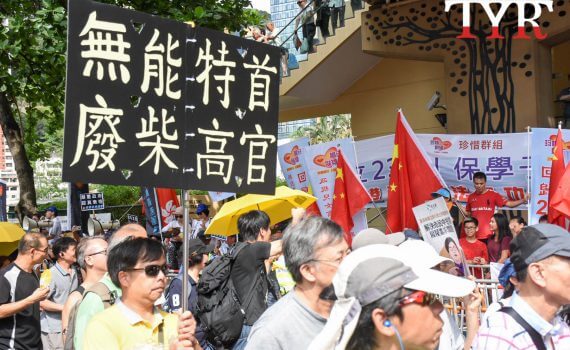Politics

July 1 protest with new starting point draws less crowd
- 2018-07-01
- Society
- The Young Reporter
- By: Katherine Li、Vanessa Yung、Nadia LamEdited by: Michael Shum、Holly Chik、Michelle Ng
- 2018-07-01
This is the second year the starting point of the July 1 march has been changed to the Central Lawn of the Victoria Park while the number of participants continues to drop. About 50,000 people joined the rally this year as the organiser reported, while the police claimed there are 9,800 people at peak, which was the lowest since 2003. For the second consecutive year, the organiser failed to reserve the soccer pitches as the starting point due to the handover celebration organised by The Hong Kong Celebrations Association. The application to assemble at East Point Road also failed later. Au Nok-hin, the vice-convener of the Civil Human Rights Front, called for citizens not to join the rally at East Point Road. He claimed that the participants could join at the Hysan place or Wan Chai Computer Centre instead. "I am worried that the police will find opportunities to arrests citizens in East Point Road. I know that there are already dozens of police there. The grip placed on protests have definitely tightened," Mr. Au said before the protest started. As TYR reporters observed, the participants could join or leave the rally freely during the march. However, in some places with crowd control barriers in place, people are not allowed to enter. According to the Leisure and Cultural Services Department, The Celebrations Association was given priority since it is a registered charity group under the Inland Revenue Ordinance. Different parties have different complaints towards the government. In regards to democracy, Martin Lee, founder of the Democratic Party in Hong Kong, believes that Carrie Lam is not doing enough. "My greatest complaint about the current government is that this chief executive has done nothing, nothing in this past one year, about democracy," said Mr. Lee. "The Basic Law has been interpreted by the …

China aims to lift 10 million people out of poverty
- 2018-03-07
- Politics
- The Young Reporter
- By: Katherine Li、Wallis WangEdited by: Alexandra Lin、Zinnia Lee
- 2018-03-07
Reported by Katherine Li and Wallis Wang Edited by Alexandra Lin and Zinnia Lee China will step up efforts to alleviate poverty using targeted measures and promote the development of local industries, education and healthcare, Premier Li Keqiang revealed in his government report speech. "This year, we will further reduce the poor rural population by over 10 million, including 2.8 million people who are to be relocated from inhospitable areas," Premier Li said. Cheung Siu-wai, a China analyst, explained that there will be more cooperation between local and central government and a case-by-case focus on poverty alleviation. "The government will allocate resources in coordination with local authorities, which means they will find out specific issues and difficulties in different locations in order to find a solution," Mr. Cheung said. Zuo Hongding, deputy director of Jinsha County Agriculture and Animal Husbandry Bureau that works on poverty alleviation in Guizhou province, said different areas need different approaches to alleviate poverty. "For mountainous areas that cannot be easily reached, we have no choice but to relocate the people. A family of five who we helped in 2015 was relocated to a 100 square meter house and was provided with livestock and fertilisers. And now they are well above the poverty line," Mr. Zuo said. The bureau where he works has helped more than 1,000 families in the town of Qinchi in Guizhou province. They plan to lift another 10,000 people out of poverty in the county over the next three years. Premier Li also announced that the government will "take targeted measures against corruption and misconduct in poverty alleviation and improve the methods used in evaluation and oversight" to manage the poverty alleviation funds more effectively. Mr. Cheung supported the new approaches on fund and resource allocation in targeted poverty relief. "In …








